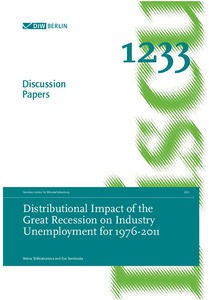Distributional impact of the Great Recession on industry unemployment 1976-2011
"The recession the United States economy entered in December of 2007 is considered to be the most severe downturn the country has experienced since the Great Depression. In this paper we decompose the changes in the unemployment rate by examining worker ows into and out of unemployment during t...
| Main Authors: | , |
|---|---|
| Institution: | ETUI-European Trade Union Institute |
| Format: | TEXT |
| Language: | English |
| Published: |
Berlin
2012
DIW |
| Subjects: | |
| Online Access: | https://www.labourline.org/KENTIKA-19132646124919508289-Distributional-impact-of-the-G.htm |
| Summary: | "The recession the United States economy entered in December of 2007 is considered to be the most severe downturn the country has experienced since the Great Depression. In this paper we decompose the changes in the unemployment rate by examining worker ows into and out of unemployment during the last four recessions in the United States with a special focus on the industry groups. Since the most recent economic downturn has been triggered by the collapse of the housing market, we are interested in looking at the industries that are most affected by the housing market weakness (such as construction and finance, insurance and real estate). In addition to documenting and comparing industry experiences and industry contributions to the aggregate unemployment rate changes, we attempt to evaluate the relative importance of cyclical and structural forces driving industry-specific unemployment rate changes. This question is of importance to policymakers as cyclical and structural changes call for different policy responses. We use publicly available data from the Current Population Survey (CPS). Three series are necessary to compute the unemployment inow and outow rates by industry: the number of unemployed, the unemployment rate and the number of short-term unemployed (those unemployed for less than 5 weeks). These series for the broadest industry classification are available from BLS, but only from 2000. We obtain data that goes back beyond 2000 and reclassify according the BLS guidelines. Our task is complicated by the change in industry classification of the CPS in 1983 and 2003 and the 1994 re-design of the CPS survey. We extend our data further back and look at a finer disaggregation, which allows us to make comparisons previously not possible. We find that construction, manufacturing and services were the three industries that contributed the most to the aggregate unemployment rate increase during the most recent downturn. However, the burden of unemployment was not evenly distributed across these industries: while the contribution of construction and manufacturing by far exceeded their share in the labor force, the opposite is the case for services. During the recovery, construction and manufacturing are strong "drivers" of the unemployment rate decline, but services are not. In terms of job ows, the dramatic decline in the job finding probability was the main source of the recessionary unemployment rate increase. In particular, the decline in job finding probability in services, manufacturing, construction and wholesale and retail trade were large contributors. It is the lack of strong recovery in job finding probability that seems to be holding unemployment rate from declining more rapidly during the recovery. Services and public administration stand out as sectors that provided relief in the past recoveries, but are not doing so this time around." |
|---|---|
| Physical Description: | 34 p. Digital |

